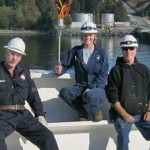By LINDA ROBINSON
Council Outreach Coordinator
A group interested in creating new educational materials about oil spills met in the council’s Anchorage office this past March.
Three of the organizations represented, the Prince William Sound Science Center, the Alaska SeaLife Center, and the council were already working on their own projects to create materials on oil spills. The science center’s plan was to compile a database of oil spill educational material focusing on all of Alaska, including the Arctic. The Alaska SeaLife Center, using funding from a grant from National Oceanic and Atmospheric Administration, or NOAA, was planning to create materials on spills that occurred in the United States to help train staff to interact with the public on difficult, controversial or complicated topics. The council was just beginning the process of updating our Alaska Oil Spill Curriculum, which focused on the Exxon Valdez oil spill region. A collaborative effort by the Prince William Sound Science Center, the Oil Spill Recovery Institute and the council created that curriculum and last updated it in 2007.
The three organizations decided to once again pool resources into one project and invited representatives from Kodiak College, the Sitka Sound Science Center, and NOAA’s Auke Bay Lab to join the discussion.
Also joining the meeting was Katie Gavenus, project director for Children of the Spills, one of the council’s youth involvement projects. Katie interviewed people in the Exxon Valdez oil spill region who experienced an oil spill as a youth. You can find some of the project’s videos and interviews at: Children of the Spills
The group talked about goals for the new collaborative curriculum. In order to appeal to a broad audience, large spills around the U.S. will be included. Lesson plans will cover a variety of subjects such as science, writing and history so teachers don’t have to find time in their schedules for a separate curriculum.
The curriculum is expected to focus on the beauty, intricacy and science of ecosystems, how everything is inter-related, and why we should care about and protect it. The group is also working to include some information from the perspective of the oil industry such as what oil is, how it is produced, products we use that are made from oil and current oil spill prevention and response capabilities.
The curriculum will also include energy conservation and renewable energy topics. Older students will study more technical information and learn about oil spills as technological disasters. They will learn how people respond differently to natural disasters than to technological (or man-made) disasters and how important it is to be aware of this and to teach proper response. Information for this part of the curriculum will be taken from the council’s Coping with Technological Disasters Guidebook. For more information on this guidebook, visit our Coping with Technological Disasters page.
The old curriculum is still available on our website, but will be updated within the next few months. If you have questions or comments, please email me. Have a wonderful summer!
